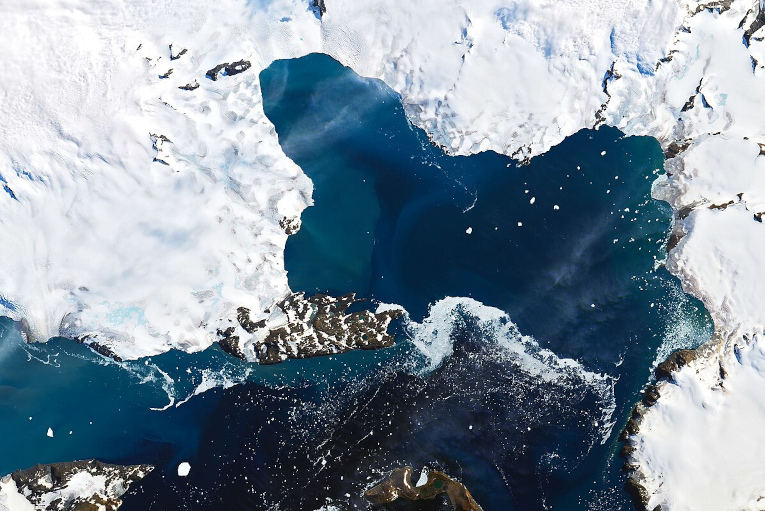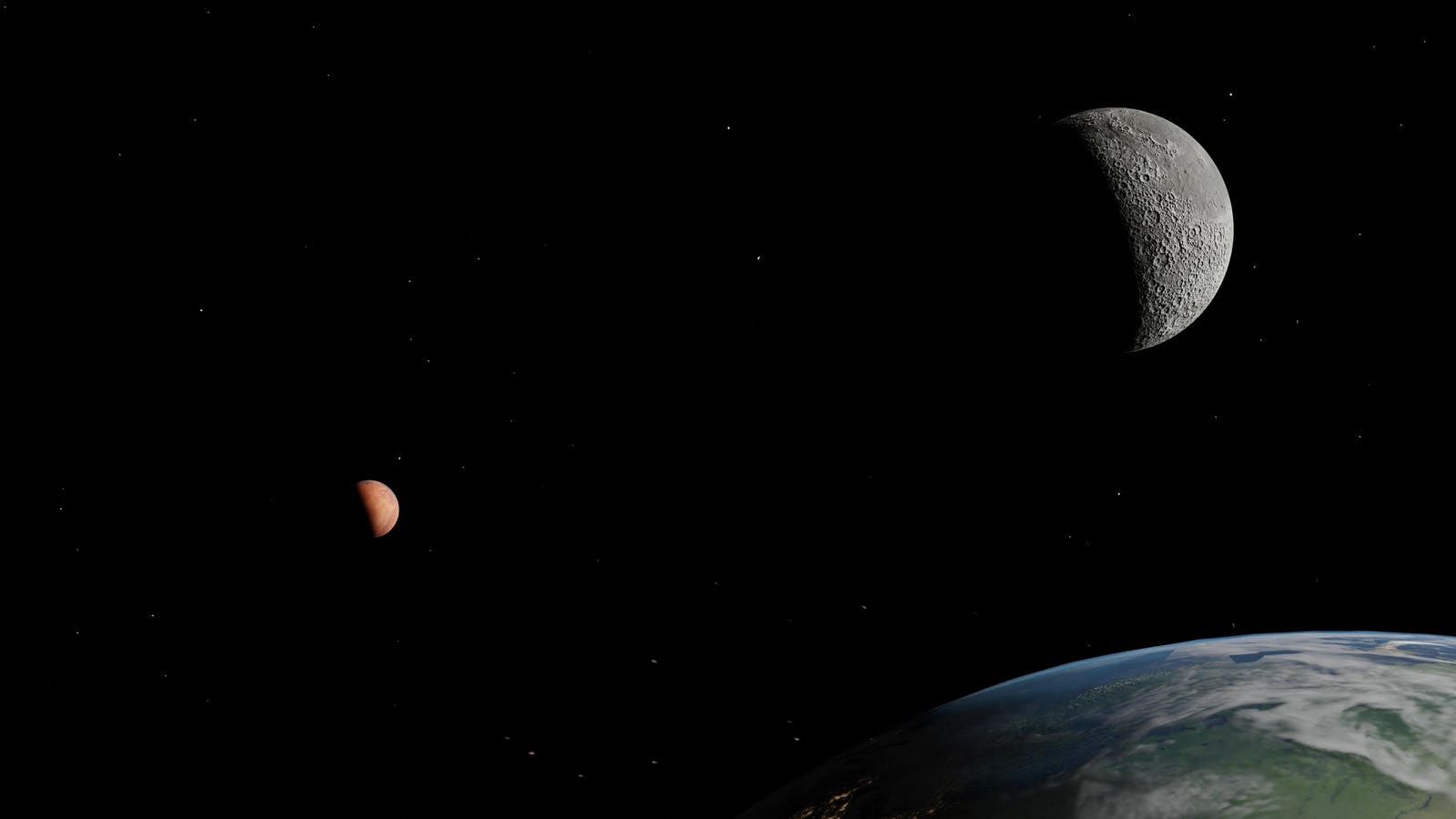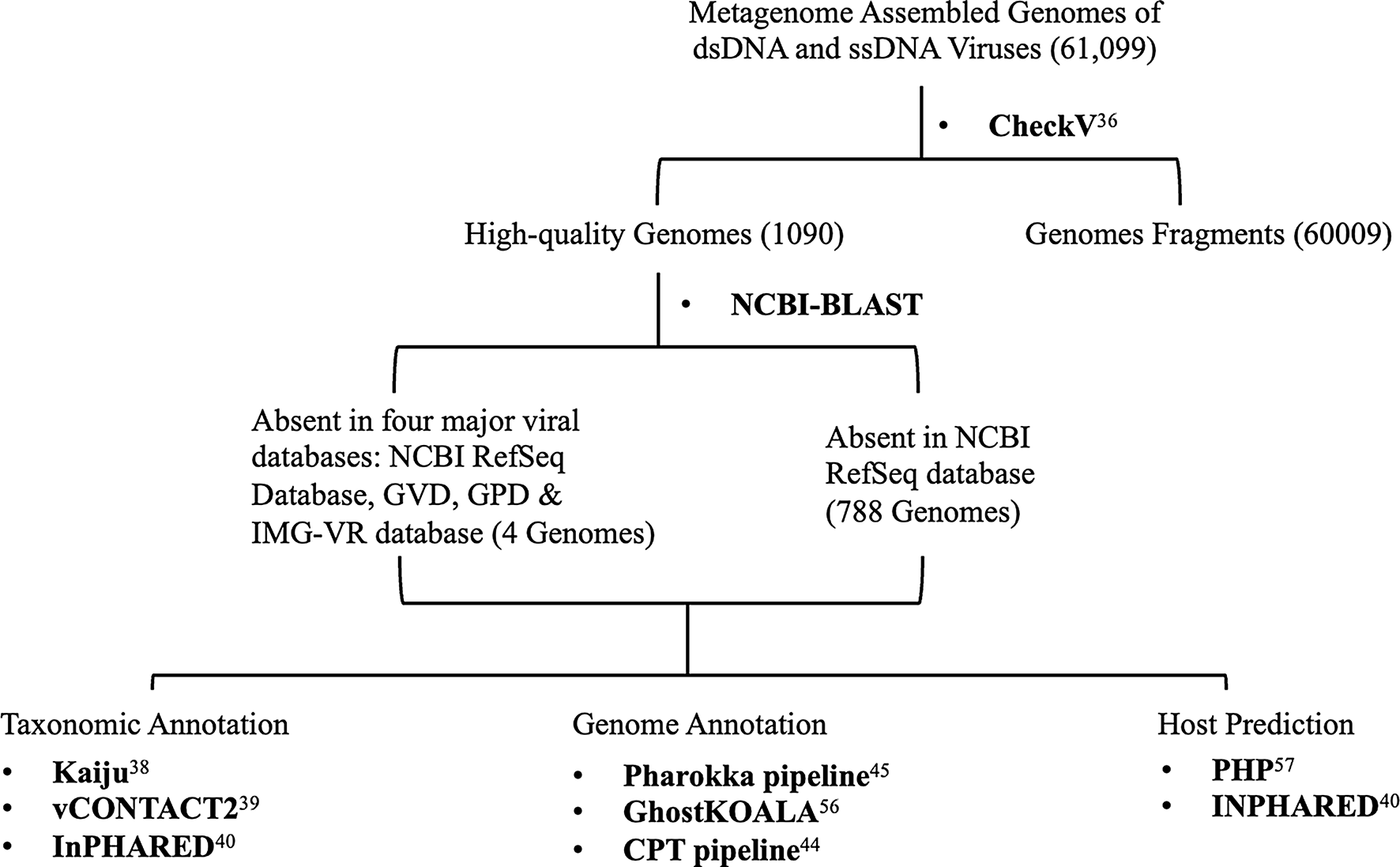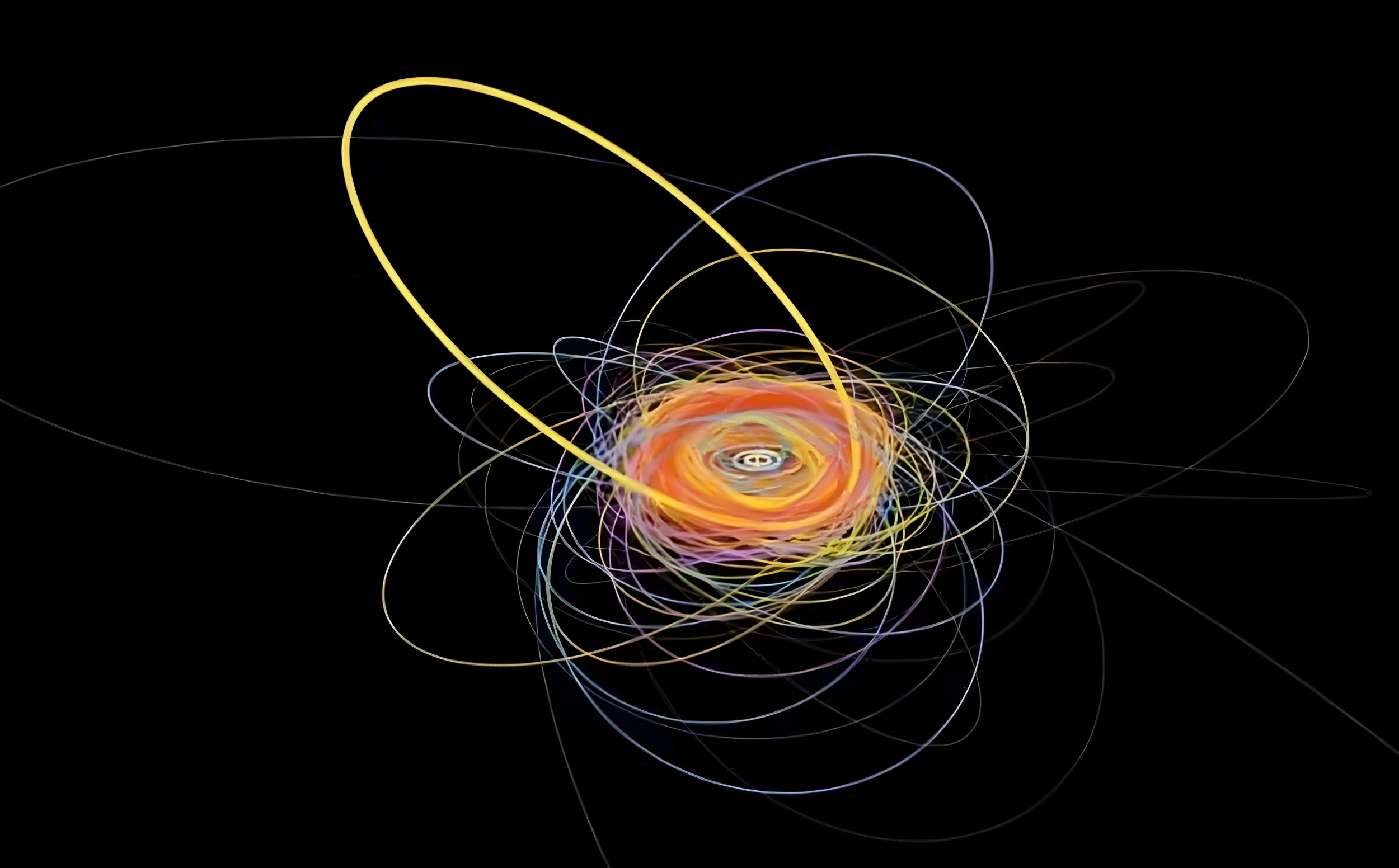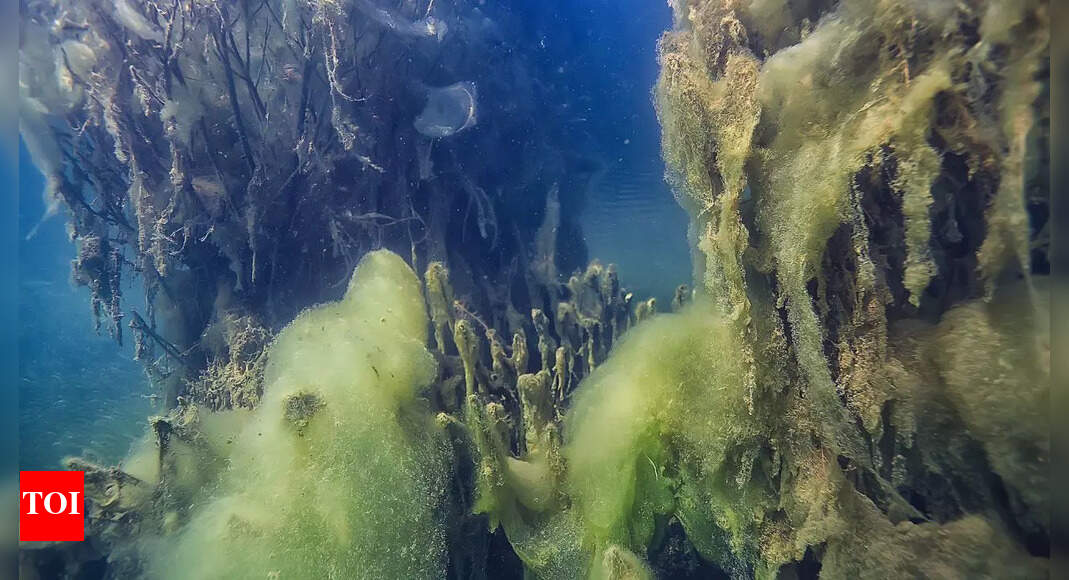Páez-Espino D, et al. Uncovering Earth’s Virome. Nature. 2016;536:425–30.
PubMed
Google Scholar
Shi M, et al. Redefining the invertebrate RNA virosphere. Nature. 2016;540:539–43.
CAS
PubMed
Google Scholar
Dayaram A, et al. Diverse circular replication-associated protein encoding viruses Circulating in invertebrates within a lake ecosystem. Infect Genet Evol. 2016;39:304–16.
CAS
PubMed
Google Scholar
Roux S, et al. Ecogenomics and potential biogeochemical impacts of globally abundant ocean viruses. Nature. 2016;537:689–93.
CAS
PubMed
Google Scholar
Arkhipova K, et al. Temporal dynamics of uncultured viruses: a new dimension in viral diversity. ISME J. 2018;12:199–211.
PubMed
Google Scholar
Wilson WH, et al. Genomic exploration of individual giant ocean viruses. ISME J. 2017;11:1736–45.
PubMed
PubMed Central
Google Scholar
Simmonds P, Adams M, Benkő M, et al. Virus taxonomy in the age of metagenomics. Nat Rev Microbiol. 2017;15:161–8. https://doi.org/10.1038/nrmicro.2016.177.
Article
CAS
PubMed
Google Scholar
Krupovic M, Ghabrial SA, Jiang D, Varsani A. Genomoviridae: a new family of widespread single-stranded DNA viruses. Arch Virol. 2016;161(9):2633–43. https://doi.org/10.1007/s00705-016-2943-3.
Article
CAS
PubMed
Google Scholar
Shi M, Lin XD, Tian JH, et al. Redefining the invertebrate RNA virosphere. Nature. 2016;540:539–43. https://doi.org/10.1038/nature20167.
Article
CAS
PubMed
Google Scholar
Labonté JM, Suttle CA. Previously unknown and highly divergent SsDNA viruses populate the oceans. ISME J. 2013;7(11):2169–77. https://doi.org/10.1038/ismej.2013.110.
Article
CAS
PubMed
PubMed Central
Google Scholar
Dayaram A, Goldstien S, Argüello-Astorga GR, Zawar-Reza P, Gomez C, Harding JS, Varsani A. Diverse small circular DNA viruses Circulating amongst estuarine molluscs. Infect Genet Evol. 2015;31:284–95. https://doi.org/10.1016/j.meegid.2015.02.010.
Article
CAS
PubMed
Google Scholar
Dayaram A, Galatowitsch ML, Argüello-Astorga GR, van Bysterveldt K, Kraberger S, Stainton D, Harding JS, Roumagnac P, Martin DP, Lefeuvre P, Varsani A. Diverse circular replication-associated protein encoding viruses Circulating in invertebrates within a lake ecosystem. Infect Genet Evol. 2016;39:304–16. https://doi.org/10.1016/j.meegid.2016.02.011.
Article
CAS
PubMed
Google Scholar
Rosario K, Schenck RO, Harbeitner RC, Lawler SN, Breitbart M. Novel circular single-stranded DNA viruses identified in marine invertebrates reveal high sequence diversity and consistent predicted intrinsic disorder patterns within putative structural proteins. Front Microbiol. 2015;6:696.
PubMed
PubMed Central
Google Scholar
Yutin N, Shevchenko S, Kapitonov V, Krupovic M, Koonin EV. A novel group of diverse Polinton-like viruses discovered by metagenome analysis. BMC Biol. 2015;13:95. https://doi.org/10.1186/s12915-015-0207-4.
Article
CAS
PubMed
PubMed Central
Google Scholar
Zhou J, Zhang W, Yan S, Xiao J, Zhang Y, Li B, Pan Y, Wang Y. Diversity of virophages in metagenomic data sets. J Virol. 2013;87(8):4225. https://doi.org/10.1128/JVI.03398-12.
Article
CAS
PubMed
PubMed Central
Google Scholar
Dutilh BE, Cassman N, McNair K, Sanchez SE, Silva GG, Boling L, Barr JJ, Speth DR, Seguritan V, Aziz RK, Felts B, Dinsdale EA, Mokili JL, Edwards RA. A highly abundant bacteriophage discovered in the unknown sequences of human faecal metagenomes. Nat Commun. 2014;5:4498. https://doi.org/10.1038/ncomms5498.
Article
CAS
PubMed
Google Scholar
Yutin N, Kapitonov VV, Koonin EV. A new family of hybrid virophages from an animal gut metagenome. Biol Direct. 2015;10:19. https://doi.org/10.1186/s13062-015-0054-9.
Article
CAS
PubMed
PubMed Central
Google Scholar
Zhang W, Zhou J, Liu T, Yu Y, Pan Y, Yan S, Wang Y. Four novel algal virus genomes discovered from Yellowstone lake metagenomes. Sci Rep. 2015;5:15131. https://doi.org/10.1038/srep15131.
Article
CAS
PubMed
PubMed Central
Google Scholar
Yau S, Lauro FM, DeMaere MZ, Brown MV, Thomas T, Raftery MJ, Andrews-Pfannkoch C, Lewis M, Hoffman JM, Gibson JA, Cavicchioli R. Virophage control of Antarctic algal host-virus dynamics. Proc Natl Acad Sci U S A. 2011;108(15):6163. https://doi.org/10.1073/pnas.1018221108.
Article
PubMed
PubMed Central
Google Scholar
Schmidtke DT, Hickey AS, Liachko I, Sherlock G, Bhatt AS. Analysis and culturing of [preprint].e [preprint].ototypic crassphage [preprint].veals a [preprint].age-plasmid lifestyle. BioRxiv [Preprint]. 2024 Mar 20:2024.03.20.585998. https://doi.org/10.1101/2024.03.20.585998
Roux S, Hawley AK, Beltran MT, Scofield M, Schwientek P, Stepanauskas R, Woyke T, Hallam SJ, Sullivan MB. Ecology and evolution of viruses infecting uncultivated SUP05 bacteria as revealed by single-cell- and meta-genomics. eLife Sci. 2014;3:e03125.
Google Scholar
Mojica FJM, Díez-Villaseñor C, García-Martínez J, Soria E. Intervening sequences of regularly spaced prokaryotic repeats derive from foreign genetic elements. J Mol Evol. 2005;60:174.
CAS
PubMed
Google Scholar
Pourcel C, Salvignol G, Vergnaud GY. CRISPR elements in Yersinia pestis acquire new repeats by Preferential uptake of bacteriophage DNA, and provide additional tools for evolutionary studies. Microbiology. 2005;151:653.
CAS
PubMed
Google Scholar
Cong L, Ran FA, Cox D, Lin S, Barretto R, Habib N, Hsu PD, Wu X, Jiang W, Marraffini LA, et al. Multiplex genome engineering using CRISPR/Cas systems. Science. 2013;339:819.
CAS
PubMed
PubMed Central
Google Scholar
Bragg JG, Chisholm SW. Modeling the fitness consequences of a Cyanophage-Encoded photosynthesis gene. PLoS ONE. 2008;3:e3550.
PubMed
PubMed Central
Google Scholar
Mann NH, Cook A, Millard A, Bailey S, Clokie M. Bacterial photosynthesis genes in a virus. Nature. 2003;424:741.
CAS
PubMed
Google Scholar
Trubl G, Jang HB, Roux S, Emerson JB, Solonenko N, Vik DR, Solden L, Ellenbogen J, Runyon AT, Bolduc B, et al. Soil viruses are underexplored players in ecosystem carbon processing. mSystems. 2018;3:e00076–18.
CAS
PubMed
PubMed Central
Google Scholar
Chen L-X, Méheust R, Crits-Christoph A, McMahon KD, Nelson TC, Slater GF, Warren LA, Banfield JF. Large freshwater phages with the potential to augment aerobic methane oxidation. Nat Microbiol. 2020;5:1504.
CAS
PubMed
PubMed Central
Google Scholar
Roux S, Brum JR, Dutilh BE, Sunagawa S, Duhaime MB, Loy A, Poulos BT, Solonenko N, Lara E, Poulain J, et al. Ecogenomics and potential biogeochemical impacts of globally abundant ocean viruses. Nature. 2016;537:689.
CAS
PubMed
Google Scholar
Kieft K, Breister AM, Huss P, Linz AM, Zanetakos E, Zhou Z, Rahlff J, Esser SP, Probst AJ, Raman S, et al. Virus-associated organosulfur metabolism in human and environmental systems. Cell Rep. 2021;36:109471.
CAS
PubMed
Google Scholar
Kieft K, Zhou Z, Anderson RE, Buchan A, Campbell BJ, Hallam SJ, Hess M, Sullivan MB, Walsh DA, Roux S, et al. Ecology of inorganic sulfur auxiliary metabolism in widespread bacteriophages. Nat Commun. 2021;12:3503.
CAS
PubMed
PubMed Central
Google Scholar
Fujimoto K, Kimura Y, Shimohigoshi M, Satoh T, Sato S, Tremmel G, Uematsu M, Kawaguchi Y, Usui Y, Nakano Y, et al. Metagenome data on intestinal phage-Bacteria associations aids the development of phage therapy against pathobionts. Cell Host Microbe. 2020;28:380.
CAS
PubMed
Google Scholar
Mangalea MR, Paez-Espino D, Kieft K, Chatterjee A, Chriswell ME, Seifert JA, Feser ML, Demoruelle MK, Sakatos A, Anantharaman K, et al. Individuals at risk for rheumatoid arthritis harbor differential intestinal bacteriophage communities with distinct metabolic potential. Cell Host Microbe. 2021;29:726.
CAS
PubMed
PubMed Central
Google Scholar
Clooney AG, Sutton TDS, Shkoporov AN, Holohan RK, Daly KM, O’Regan O, Ryan FJ, Draper LA, Plevy SE, Ross RP, et al. Whole-Virome analysis sheds light on viral dark matter in inflammatory bowel disease. Cell Host Microbe. 2019;26:764.
CAS
PubMed
Google Scholar
Bhardwaj K, Garg A, Pandey AD, Sharma H, Kumar M, Vrati S. Insights into the human gut Virome by sampling a population from the Indian Subcontinent. J Gen Virol. 2022;103(8). https://doi.org/10.1099/jgv.0.001774.
Nayfach S, Camargo AP, Schulz F, et al. CheckV assesses the quality and completeness of metagenome-assembled viral genomes. Nat Biotechnol. 2021;39:578. https://doi.org/10.1038/s41587-020-00774-7.
Article
CAS
PubMed
Google Scholar
Schackart KE 3rd, Graham JB, Ponsero AJ, Hurwitz BL. Evaluation of computational phage detection tools for metagenomic datasets. Front Microbiol. 2023;14:1078760. https://doi.org/10.3389/fmicb.2023.1078760.
Article
PubMed
PubMed Central
Google Scholar
Menzel P, Ng K, Krogh A. Fast and sensitive taxonomic classification for metagenomics with Kaiju. Nat Commun. 2016;7:11257.
CAS
PubMed
PubMed Central
Google Scholar
Bin Jang H, Bolduc B, Zablocki O, et al. Taxonomic assignment of uncultivated prokaryotic virus genomes is enabled by gene-sharing networks. Nat Biotechnol. 2019;37:632. https://doi.org/10.1038/s41587-019-0100-8.
Article
CAS
PubMed
Google Scholar
Cook R, Brown N, Redgwell T, Rihtman B, Barnes M, Clokie M, Stekel DJ, Hobman J, Jones MA, Millard A. INfrastructure for a phage reference database: identification of Large-Scale biases in the current collection of cultured phage genomes. Phage (New Rochelle). 2021;2(4):214. https://doi.org/10.1089/phage.2021.0007.
Article
PubMed
Google Scholar
Turner D, Shkoporov AN, Lood C, Millard AD, Dutilh BE, Alfenas-Zerbini P, van Zyl LJ, Aziz RK, Oksanen HM, Poranen MM, Kropinski AM, Barylski J, Brister JR, Chanisvili N, Edwards RA, Enault F, Gillis A, Knezevic P, Krupovic M, Kurtböke I, Kushkina A, Lavigne R, Lehman S, Lobocka M, Moraru C, Moreno Switt A, Morozova V, Nakavuma J, Reyes Muñoz A, Rūmnieks J, Sarkar BL, Sullivan MB, Uchiyama J, Wittmann J, Yigang T, Adriaenssens EM. Abolishment of morphology-based taxa and change to binomial species names: 2022 taxonomy update of the ICTV bacterial viruses subcommittee. Arch Virol. 2023;168(2):74. https://doi.org/10.1007/s00705-022-05694-2.
Article
CAS
PubMed
PubMed Central
Google Scholar
Moraru C, Varsani A, Kropinski AM. VIRIDIC-A novel tool to calculate the intergenomic similarities of Prokaryote-Infecting viruses. Viruses. 2020;12(11):1268. https://doi.org/10.3390/v12111268.
Article
CAS
PubMed
PubMed Central
Google Scholar
Turner D, Adriaenssens EM, Tolstoy I, Kropinski AM. Phage annotation guide: guidelines for assembly and High-Quality annotation. Phage (New Rochelle). 2021;2(4):170. https://doi.org/10.1089/phage.2021.0013.
Article
PubMed
Google Scholar
Ramsey J, Rasche H, Maughmer C, Criscione A, Mijalis E, Liu M, et al. Galaxy and Apollo as a biologist-friendly interface for high-quality cooperative phage genome annotation. PLoS Comput Biol. 2020;16(11):e1008214. https://doi.org/10.1371/journal.pcbi.1008214.
Article
CAS
PubMed
PubMed Central
Google Scholar
Bouras G, Nepal R, Houtak G, Psaltis AJ, Wormald P-J. Sarah Vreugde, Pharokka: a fast scalable bacteriophage annotation tool. Bioinformatics. 2023;39. https://doi.org/10.1093/bioinformatics/btac776.
McNair K, Zhou C, Dinsdale EA, Souza B, Edwards RA. PHANOTATE: a novel approach to gene identification in phage genomes. Bioinformatics. 2019;35(22):4537. https://doi.org/10.1093/bioinformatics/btz265.
Article
CAS
PubMed
PubMed Central
Google Scholar
Skennerton CT, Soranzo N, Angly F. MinCED. https://github.com/ctSkennerton/minced
Patricia P, Chan, Brian Y, Lin AJ, Mak, Todd M, Lowe. tRNAscan-SE 2.0: improved detection and functional classification of transfer RNA genes. Nucleic Acids Res. 2021;49:9077.
Google Scholar
Laslett D, Canback B. ARAGORN, a program to detect tRNA genes and TmRNA genes in nucleotide sequences. Nucleic Acids Res. 2004;32(1):11–6. https://doi.org/10.1093/nar/gkh152.
Article
CAS
PubMed
PubMed Central
Google Scholar
Brian P, Alcock AR, Raphenya, Tammy TY, Lau KK, Tsang Mégane, Bouchard A, Edalatmand W, Huynh, Anna-Lisa V, Nguyen AA, Cheng S, Liu, Sally Y, Min A, Miroshnichenko H-K, Tran RE, Werfalli JA, Nasir M, Oloni DJ, Speicher N, Sharma E, Bordeleau AC, Pawlowski HL, Zubyk D, Dooley E, Griffiths F, Maguire GL, Winsor RG, Beiko, Fiona SL, Brinkman WWL, Hsiao GV, Domselaar, Andrew G, McArthur. CARD 2020: antibiotic resistome surveillance with the comprehensive antibiotic resistance database, Nucleic Acids Research, 48, D517, (2020). https://doi.org/10.1093/nar/gkz935
Liu B, Zheng D, Zhou S, Chen L, Yang J. VFDB 2022: a general classification scheme for bacterial virulence factors. Nucleic Acids Res. 2022;50(D1):D912–7. https://doi.org/10.1093/nar/gkab1107.
Article
CAS
PubMed
Google Scholar
Paul Terzian EO, Ndela C, Galiez J, Lossouarn. Rubén Enrique Pérez Bucio, robin mom, Ariane Toussaint, Marie-Agnès Petit, François Enault, PHROG: families of prokaryotic virus proteins clustered using remote homology. NAR Genomics Bioinf. 2021;3. https://doi.org/10.1093/nargab/lqab067.
Bonnie L, Hurwitz, Jana M, U’Ren. Viral metabolic reprogramming in marine ecosystems. Curr Opin Microbiol. 2016;31:161. https://doi.org/10.1016/j.mib.2016.04.002.
Article
CAS
Google Scholar
Kieft K, Zhou Z, Anantharaman K. VIBRANT: automated recovery, annotation and curation of microbial viruses, and evaluation of viral community function from genomic sequences. Microbiome. 2020;8(1):90. https://doi.org/10.1186/s40168-020-00867-0.
Article
CAS
PubMed
PubMed Central
Google Scholar
Luo XQ, Wang P, Li JL, et al. Viral community-wide auxiliary metabolic genes differ by lifestyles, habitats, and hosts. Microbiome. 2022;10:190. https://doi.org/10.1186/s40168-022-01384-y.
Article
PubMed
PubMed Central
Google Scholar
Kanehisa M, Sato Y, Morishima K. BlastKOALA and GhostKOALA: KEGG tools for functional characterization of genome and metagenome sequences. J Mol Biol. 2016;428(4):726. https://doi.org/10.1016/j.jmb.2015.11.006.
Article
CAS
PubMed
Google Scholar
Enault F, Briet A, Bouteille L, Roux S, Sullivan MB, Petit MA. Phages rarely encode antibiotic resistance genes: a cautionary Tale for Virome analyses. ISME J. 2017;11(1):237–47. https://doi.org/10.1038/ismej.2016.90.
Article
CAS
PubMed
Google Scholar
Lu C, Zhang Z, Cai Z, et al. Prokaryotic virus host predictor: a Gaussian model for host prediction of prokaryotic viruses in metagenomics. BMC Biol. 2021;19:5. https://doi.org/10.1186/s12915-020-00938-6.
Article
CAS
PubMed
PubMed Central
Google Scholar
Liang G, Cobián-Güemes AG, Albenberg L, et al. The gut Virome in inflammatory bowel diseases. Curr Opin Virol. 2021;51:190. https://doi.org/10.1016/j.coviro.2021.10.005.
Article
CAS
PubMed
Google Scholar
Székely AJ, Breitbart M. Single-strandedDNAphages: from early molecular biology tools to recent revolutions in environmental microbiology. FEMS Microbiol Lett 363, fnw027 (2016).
PubMed
Google Scholar
Kirchberger PC, Martinez ZA, Ochman H. Organizing the global diversity of microviruses. mBio. 2022;13(3):e0058822. https://doi.org/10.1128/mbio.00588-22.
Article
PubMed
Google Scholar
Krupovic M, Forterre P. Microviridae goes temperate: Microvirus-related proviruses reside in the genomes of bacteroidetes. PLoS ONE. 2011;6:e19893.
CAS
PubMed
PubMed Central
Google Scholar
Liang G, Bushman FD. The human Virome: assembly, composition and host interactions. Nat Rev Microbiol. 2021;19:514–27.
CAS
PubMed
PubMed Central
Google Scholar
Turner D, Kropinski AM, Adriaenssens EM. A Roadmap for Genome-Based Phage Taxonomy. Viruses 13, 506 (2021).
Casjens SR, Gilcrease EB. Determining DNA packaging strategy by analysis of the termini of the chromosomes in tailed-bacteriophage virions. Methods Mol Biol. 2009;502:91.
CAS
PubMed
PubMed Central
Google Scholar
Merrill BD, Ward AT, Grose JH, Hope S. Software-based analysis of bacteriophage genomes, physical ends, and packaging strategies. BMC Genom. 2016;17:679.
Google Scholar
Meijer WJ, Horcajadas JA, Salas M. Phi29 family of phages. Microbiol Mol Biol Rev. 2001;65:261–87.
CAS
PubMed
PubMed Central
Google Scholar
Iranzo J, Krupovic M, Koonin EV. The Double-Stranded DNA virosphere as a modular hierarchical network of gene sharing. mBio. 2016;7:e00978–16.
CAS
PubMed
PubMed Central
Google Scholar
Adriaenssens EM. Phage diversity in the human gut microbiome: A taxonomist’s perspective. mSystems. 2021;6:e0079921.
PubMed
Google Scholar
Mantynen S, Laanto E, Oksanen HM, Poranen MM, Diaz-Munoz SL. Black box of phage-bacterium interactions: exploring alternative phage infection strategies. Open Biol. 2021;11:210188.
CAS
PubMed
PubMed Central
Google Scholar
Howard-Varona C, Hargreaves KR, Abedon ST, Sullivan MB. Lysogeny in nature: mechanisms, impact and ecology of temperate phages. ISME J. 2017;11:1511.
PubMed
PubMed Central
Google Scholar
Veses-Garcia M, Liu X, Rigden DJ, Kenny JG, McCarthy AJ, Allison HE. Transcriptomic analysis of Shiga-toxigenic bacteriophage carriage reveals a profound regulatory effect on acid resistance in Escherichia coli. Appl Environ Microbiol. 2015;81:8118. https://doi.org/10.1128/AEM.02034-15.
Article
CAS
PubMed
PubMed Central
Google Scholar
Mai-Prochnow A, Hui JG, Kjelleberg S, Rakonjac J, McDougald D, Rice SA. Big things in small packages: the genetics of filamentous phage and effects on fitness of their host’. FEMS Microbiol Rev. 2015;39:465. https://doi.org/10.1093/femsre/fuu007).
Article
PubMed
Google Scholar
Jahn MT, Arkhipova K, Markert SM, et al. A phage protein aids bacterial symbionts in eukaryote immune evasion. Cell Host Microbe. 2019;26. https://doi.org/10.1016/j.chom.2019.08.019. 542– 50 e5.
Aktories K, Schwan C, Jank T. Clostridium difficile toxin biology. Annu Rev Microbiol. 2017;71:281. https://doi.org/10.1146/annurev-micro-090816-093458.
Article
CAS
PubMed
Google Scholar
Wu R, Smith CA, Buchko GW, et al. Structural characterization of a soil viral auxiliary metabolic gene product– a functional Chitosanase. Nat Commun. 2022;13:5485. https://doi.org/10.1038/s41467-022-32993-8.
Article
CAS
PubMed
PubMed Central
Google Scholar
Coutinho FH, Silveira CB, Gregoracci GB, Thompson CC, Edwards RA, Brussaard CPD, et al. Marine viruses discovered via metagenomics shed light on viral strategies throughout the oceans. Nat Commun. 2017;8:15955.
CAS
PubMed
PubMed Central
Google Scholar
Hurwitz BL, Brum JR, Sullivan MB. Depth-stratified functional and taxonomic niche specialization in the core and flexible Pacific ocean Virome. ISME J. 2015;9:472.
CAS
PubMed
Google Scholar
Jurėnas D, Fraikin N, Goormaghtigh F, et al. Biology and evolution of bacterial toxin–antitoxin systems. Nat Rev Microbiol. 2022;20:335. https://doi.org/10.1038/s41579-021-00661-1.
Article
CAS
PubMed
Google Scholar
Thomas C, Tampé R. Structural and mechanistic principles of ABC transporters. Annu Rev Biochem. 2020;89:605. https://doi.org/10.1146/annurev-biochem-011520-105201.
Article
CAS
PubMed
Google Scholar
Cannon RD, Lamping E, Holmes AR, Niimi K, Baret PV, Keniya MV, et al. Efflux-mediated antifungal drug resistance. Clin Microbiol Rev. 2009;22:291.
CAS
PubMed
PubMed Central
Google Scholar
Sá-Correia I, Santos SC, Teixeira MC, Cabrito TR, Mira NM. Drug:H+ antiporters in chemical stress response in yeast. Trends Microbiol. 2009;17:22.
PubMed
Google Scholar
Morschhäuser J. Regulation of multidrug resistance in pathogenic fungi. Fungal Genet Biol. 2010;47(2):94. https://doi.org/10.1016/j.fgb.2009.08.002.
Article
CAS
PubMed
Google Scholar
Mann E, Ovchinnikova OG, King JD, Whitfield C. Bacteriophage-mediated glucosylation can modify lipopolysaccharide O-Antigens synthesized by an ATP-binding cassette (ABC) Transporter-dependent assembly mechanism. J Biol Chem. 2015;290(42):25561. https://doi.org/10.1074/jbc.M115.660803.
Article
CAS
PubMed
PubMed Central
Google Scholar
Nakayashiki T, Mori H. Genome-Wide screening with hydroxyurea reveals a link between nonessential ribosomal proteins and reactive oxygen species production. J Bacteriol. 2013;195:1226. https://doi.org/10.1128/JB.02145-12.
Article
CAS
PubMed
PubMed Central
Google Scholar
Soule T, Gao Q, Stout V, Garcia-Pichel F. The global response of Nostoc punctiforme ATCC 29133 to UVA stress, assessed in a Temporal DNA microarray study. Photochem Photobiol. 2013;89:415. https://doi.org/10.1111/php.12014.
Article
CAS
PubMed
Google Scholar
